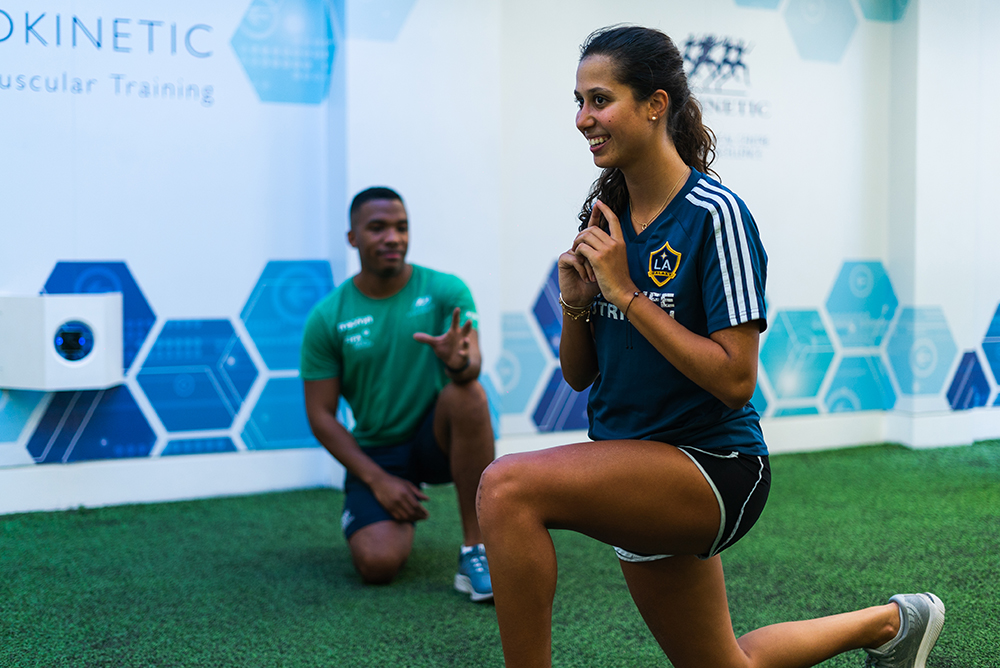Isokinetic leads search for answers around ACL injuries in women’s football
NEWS - 24TH AUGUST 2023
Studies presented at the Isokinetic Football Medicine Conference explore ACL injury prevention and rehab techniques for female footballers
The absence of several major international stars from this year’s Women’s World Cup highlighted the striking prevalence and heartbreaking consequences of anterior cruciate ligament (ACL) injuries in women’s football. Isokinetic Medical Group, which has a sports medicine clinic on Harley Street, has been at the forefront of efforts to better understand why the occur and how their impact can be mitigated.
New data recently presented at the Isokinetic Football Medicine Conference in London revealed optimum prevention and rehabilitation techniques for female footballers with ACL injuries. In a groundbreaking series of studies, researchers identified four distinct match situations that lead to ACL injury in women’s football; concluded that early use of a hydrotherapy pool is essential in rehabilitation; affirmed the need for early access to rehabilitation to prevent loss of performance; found that players want the menstrual cycle to be the subject of education and monitoring; and showed that specific intervention training can help alleviate the likelihood of ACL injury

A rehab session at the Isokinetic clinic on Harley Street
Four distinct match situations cause ACL injury
A German study analysed 35 ACL injuries in professional women’s football between 2016 and 2022 and sought to identify mechanical patterns. They found that 43% were non-contact injuries, 40% were indirect contact injuries and 17% were direct contact injuries. Of the non-contact injuries, nearly half (47%) were sustained during the first 15 minutes of the match. Horizontal movements dominated. Injuries occurred in four distinct match situations:
— Non-contact ‘defensive pressing and abrupt stop
— non-contact landing and twist
— Indirect contact mechanism ‘parallel sprint and tackle’
— Direct ‘knee to knee’
Hydrotherapy can have a significant impact on rehab
The aim of a study from Isokinetic Medical Group was to measure the impact of early neuromotor training in water. The main targets of the pool period were recovery of movement, core stability improvement and gait normalisation. The study took place over 30 days, based on 10 sessions per week. The results showed that patients achieved a good quality of movement in a relatively short period (131 days from surgery). This allows the patient to move onto on-land high-intensity neuromotor training in optimal condition. The higher level of functional strength was supported by a better psychological profile and increased ability to carry out an optimal movement analysis test.
Early intervention rehabilitation is vital
A study from Prime Health Manchester reported on a female footballer whose rehabilitation plan lacked focus due to the Covid-19 pandemic, resulting in slow and below average improvement and low limb strength. Because of a lack of immediate rehabilitation, her scores on quadriceps, hamstring were lower, affecting high-speed running performance. The case study illustrates the need for immediate rehabilitation programmes to maintain strength and performance in the rest of the body and allow the patient to return to full performance as soon as possible.
Players want menstrual cycle monitoring and management
For a study by Glasgow Caledonian University, Rangers Football Club and the University of Birmingham, interviews and questionnaires with female professional footballers at Rangers FC were used to assess the perceived physical and psychological effect of the menstrual cycle. Most players recounted experiences of the menstrual cycle being taboo in youth football, and all reported negative symptoms during their cycle. Most agreed that tracking their cycle with club medical professionals would have a positive impact on performance and mental health. Players want coaching staff to be more knowledgeable about symptoms and management and would like to be checked in on by staff members. This would be especially crucial to alleviating anxiety in younger players.
Modification of player movement can reduce risk
A New York Yankees study concluded that modifications to an athlete’s technique can reduce the externally applied loads to the knee, increase muscle support around the knee, improve an athlete’s perception of the task and thus reduce the risk of ACL injury. The study identified four key training messages to shape a training intervention:
— Increase knee flexion at foot-strike
— Improve dynamic trunk control
— Increase gastrocnemii muscle strength and activation
— Mitigate dynamic knee valgus postures (where the angle between femur and tibia is smaller than it should be on the inside of leg)
Andrea Tartaglia, managing director of Isokinetic London, said: “There is an epidemic of ACL injuries that has sidelined many stars and sparked fear among players. The exact reasons for higher ACL tear rates in women vs men are debated, but among the theories are anatomy, hormones and other factors. We want to further the pool of research to alleviate the uncertainty and anxiety for players. Data is beginning to show us that a heavy game workload and intensity with insufficient recovery resources may contribute. There are also structural issues like poor fields and unsuitable gear and shoes. We need to give players solutions to make them feel safer on the pitch. We know that preventing recurrent ACL tears is a challenge – 40% tear again within five years and multiple ACL rehabs take a mental toll. Some players retire early out of fear of re-injury. Women’s football needs more resource and better injury prevention.”
-
NEWS
Cleveland Clinic London patient receives AR-assisted total knee replacement
Patient undergoes life-changing procedure using an augmented reality-based platform which helps tailor the surgery to their unique anatomy
-
NEWS
New treatment for Achilles tendon injuries shows promising results
New data presented at the Isokinetic conference shows that patients experienced less pain and recovered faster when treated with hyaluronic acid
-
NEWS
Alzheimer’s study shows promising results for efficacy of new drug
Clinical trials delivered by Re:Cognition Health demonstrate impact of donanemab in slowing progression of Alzheimer’s disease
-
NEWS
Isokinetic expands specialist women’s injury programme
HSMA clinic develops programme for women athletes as breakthrough study identifies risk factors for professional female footballers